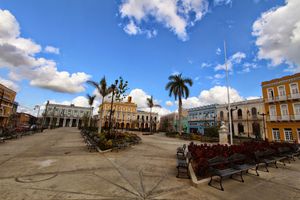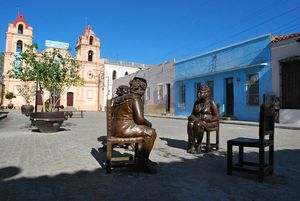

City of Camagüey
Do not forget to visit the beautiful places of the streets of Camagüey in your journey through Cuba
The City of Camagüey is also known as the Ciudad de los Tinajos de Arcilla (City of Clay Pots), and is the third biggest city in the island of Cuba, located between Ciego de Ávila and Las Tunas.
Camagüey is characterized by its unique urban plan. Its labyrinthine streets remind more of a Moroccan medina than to the typical orthogonal streets of the area. According to the legend, the reason of the winding streets and the narrow and hidden alleys was the solution to the fights with the pirates who used to attack the city. This curious street pattern was developed to confuse the invaders and protect the residents.
It was founded in 1514 as Santa María del Puerto Príncipe. The city was repeatedly moved due to the bloody rebellions until 1528 when it was settled in the present place. It wasn’t until 1903 that people started to call it Camagüey. Its economy grew during the 17th century thanks to the production of sugar and cattle breeding. Due to the lack of water, the inhabitants of Camagüey, known as agramontinos because of the locally born guerrilla fighter, had to make big clay pots to collect the water of the rain. Besides the independent fighter, Ignacio Agramonte, the city has given other celebrities like the poet Nicolás Guillén or the doctor Carlos J. Finlay, who discovered the causes of the yellow fever.
If there is something clear about Camagüey is that the city has a religious soul that the rest of the country lacks of. That is why, among its narrow streets, we discover a city made of Baroque churches and golden high altars that everybody should visit. Some of them are the Nuestra Señora de la Candelaria Cathedral, built with the collected money during the visit of the pope Juan Pablo II in 1998, or the Iglesia de Nuestra Señora de la Merced Church, the most impressive colonial church in Camagüey.
But the visitor will not only find religious buildings but also places filled with culture like San Juan de Dios Museum. This museum is located in a former hospital, and it will remind us of the history of the city. During our visit to the city, we cannot forget its beautiful squares and parks where we can enjoy a pleasant walk among historical monuments. Plaza del Carmen Square or Ignacio Agramonte Park are some of those places. Lose yourself in its amazing streets and discover the charm of its hidden corners.
Interactive map:
Camagüey
What to see:
- City of Camagüey
- Plaza del Carmen Square
- Ignacio Agramonte Park
- Casino Campestre Park
- Nuestra Señora de la Candelaria Cathedral
- Iglesia de Nuestra Señora de la Merced Church
- Iglesia de Nuestra Señora de la Soledad Church
- Iglesia del Sagrado Corazón de Jesús Church
- Iglesia de Nuestra Señora del Carmen Church
- Florida
- Sierra del Chorrillo Mountains
- Guáimaro
- Constitución Park
- Nuevitas
- Río Máximo Wildlife Park
- Brasil
- Jardines del Rey
- Cayo Cruz
- Cayo Sabinal Cay
- San Hilario Fort
- Faro Colón Lighthouse
Beaches:
Museums:
Other nearby destinations:
Why "Trip Cuba"?
Trip Cuba is an organization of Cuban agencies whose objectives are:
- ✓ To make Cuba, its culture and its heritage known.
- ✓ To promote sustainable tourism.
- ✓ To support the local economy, prioritizing direct contact with Cuban agencies.
Travel Agencies
If you are a travel agency or tour operator and you are looking forward to any assistance or collaboration to plan trips to Cuba, rely on our extensive experience
Copyright www.TripCuba.Org © - All rights reserved
All our agencies are duly registered in the National Registry of Travel Agencies of the Chamber of Commerce of the Republic of Cuba.








